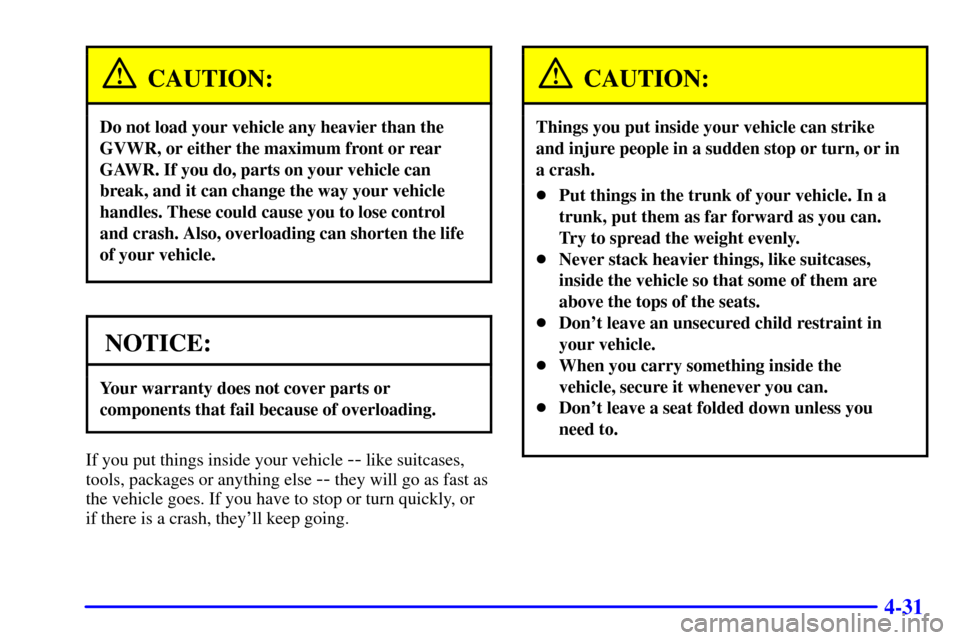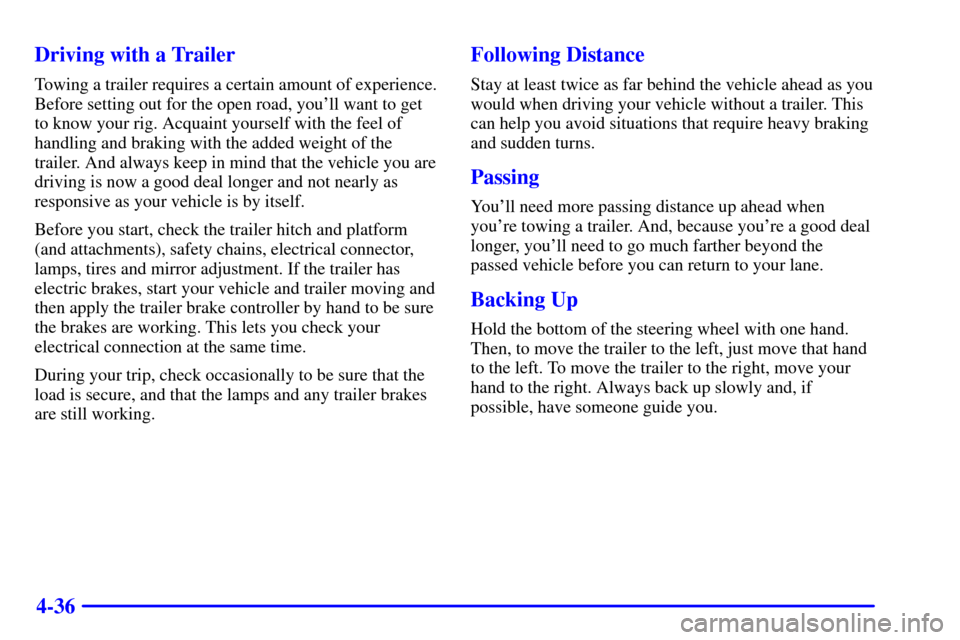Page 214 of 328

4-31
CAUTION:
Do not load your vehicle any heavier than the
GVWR, or either the maximum front or rear
GAWR. If you do, parts on your vehicle can
break, and it can change the way your vehicle
handles. These could cause you to lose control
and crash. Also, overloading can shorten the life
of your vehicle.
NOTICE:
Your warranty does not cover parts or
components that fail because of overloading.
If you put things inside your vehicle -- like suitcases,
tools, packages or anything else
-- they will go as fast as
the vehicle goes. If you have to stop or turn quickly, or
if there is a crash, they'll keep going.
CAUTION:
Things you put inside your vehicle can strike
and injure people in a sudden stop or turn, or in
a crash.
�Put things in the trunk of your vehicle. In a
trunk, put them as far forward as you can.
Try to spread the weight evenly.
�Never stack heavier things, like suitcases,
inside the vehicle so that some of them are
above the tops of the seats.
�Don't leave an unsecured child restraint in
your vehicle.
�When you carry something inside the
vehicle, secure it whenever you can.
�Don't leave a seat folded down unless you
need to.
Page 219 of 328

4-36 Driving with a Trailer
Towing a trailer requires a certain amount of experience.
Before setting out for the open road, you'll want to get
to know your rig. Acquaint yourself with the feel of
handling and braking with the added weight of the
trailer. And always keep in mind that the vehicle you are
driving is now a good deal longer and not nearly as
responsive as your vehicle is by itself.
Before you start, check the trailer hitch and platform
(and attachments), safety chains, electrical connector,
lamps, tires and mirror adjustment. If the trailer has
electric brakes, start your vehicle and trailer moving and
then apply the trailer brake controller by hand to be sure
the brakes are working. This lets you check your
electrical connection at the same time.
During your trip, check occasionally to be sure that the
load is secure, and that the lamps and any trailer brakes
are still working.
Following Distance
Stay at least twice as far behind the vehicle ahead as you
would when driving your vehicle without a trailer. This
can help you avoid situations that require heavy braking
and sudden turns.
Passing
You'll need more passing distance up ahead when
you're towing a trailer. And, because you're a good deal
longer, you'll need to go much farther beyond the
passed vehicle before you can return to your lane.
Backing Up
Hold the bottom of the steering wheel with one hand.
Then, to move the trailer to the left, just move that hand
to the left. To move the trailer to the right, move your
hand to the right. Always back up slowly and, if
possible, have someone guide you.
Page 248 of 328
5-27
NOTICE:
Improperly tightened wheel bolts can lead to
brake pulsation and rotor damage. To avoid
expensive brake repairs, evenly tighten the
wheel bolts in the proper sequence and to the
proper torque specification.
Storing a Flat or Spare Tire and Tools
CAUTION:
Storing a jack, a tire or other equipment in the
passenger compartment of the vehicle could
cause injury. In a sudden stop or collision, loose
equipment could strike someone. Store all these
in the proper place.
After you've put the spare tire on your vehicle, you'll
need to store the flat tire in the trunk. Use the following
procedure to secure the flat tire in the trunk.
1. Put the flat tire in
the trunk where
the spare is stored
(driver's side
wheel well).
2. Secure the flat tire with the straps that are used to
hold the spare in place.
Page 249 of 328

5-28
The jacking tools are stored on the passenger's side
of the trunk behind the panel with the red pull handle.
Make sure these tools are properly secured when not in use.
Spare Tire
Your vehicle is equipped with a 15º spare tire.
Although the spare tire was fully inflated when your
vehicle was new, it can lose air after a time. Check the
inflation pressure regularly.
After installing the spare tire on your vehicle, you
should stop as soon as possible and make sure your
spare tire is correctly inflated. See ªInflation
- Tire
Pressureº and ªLoading Your Vehicleº in the Index.
Your spare tire is for temporary use and should be
replaced with a full
-size tire as soon as you can.
CAUTION:
If you have a spare tire that has ª195/65R15º
on its side, your braking and handling can be
reduced if you drive more than 50 mph (80 km/h)
when this spare tire is mounted on your vehicle.
At higher speeds, you could lose control of your
vehicle, and you and others could be injured.
So, be sure not to drive more than 50 mph
(80 km/h) when you are using this spare tire.
Page 269 of 328
6-18
The access panel for the passenger compartment air
filter is below the grille, at the base of the windshield on
the passenger's side of the engine compartment. See
ªEngine Compartment Overviewº in the Index for more
information on location.
1. Open the hood of your vehicle.
2. Lift the engine compartment rear seal (see the arrow
in the illustration) and pull it back far enough to be
able to lift open the grille flap.
3. Unhook both retaining clips that secure the filter
in place.
4. Slide the filter toward the front of the car and then
pull the filter straight out.
5. Replace the filter by sliding a new one in,
reattaching both retaining clips and closing
the grille flap.
6. Reinstall the engine compartment rear seal.
7. Close the engine hood.
For the type of filter to use, see ªNormal Maintenance
Replacement Partsº in the Index.
Page 297 of 328

6-46 Tire Chains
NOTICE:
If your vehicle has 235/45R17 size tires, don't use
tire chains. They can damage your vehicle
because there's not enough clearance.
Use another type of traction device only if its
manufacturer recommends it for use on your
vehicle and tire size combination and road
conditions. Follow that manufacturer's
instructions. To help avoid damage to your
vehicle, drive slowly, readjust or remove the
device if it's contacting your vehicle, and don't
spin your wheels.
NOTICE: (Continued)
NOTICE: (Continued)
If you do find traction devices that will fit, install
them on the rear tires.
If you have other tires, use tire chains only
where legal and only when you must. Use only
SAE Class ªSº type chains that are the proper
size for your tires. Install them on the rear tires
and tighten them as tightly as possible with the
ends securely fastened. Drive slowly and follow
the chain manufacturer's instructions. If you
can hear the chains contacting your vehicle, stop
and retighten them. If the contact continues,
slow down until it stops. Driving too fast or
spinning the wheels with chains on will damage
your vehicle.